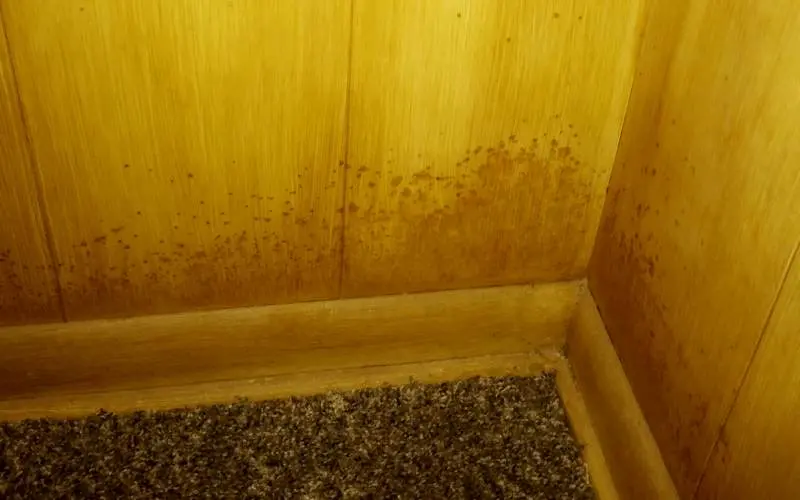Kitchen Mold Problems and Solutions

Mold Beneath the Kitchen Sink
Mold growth beneath a kitchen sink is fairly common. Numerous potential water sources exist (hot and cold supplies lines, drain line, garbage disposal, the supply line to dishwasher, etc.) Major leaks are identified and remedied quickly. Water spilling out on your kitchen floor is tough to miss. Slow leaks often go unattended for months because the cabinet is typically used to store cleaning materials, garbage can, etc. These items block the view of the cabinet bottom and sheetrock wall.
Mold growth beneath the sink doesn’t necessarily indicate an active leak. Because mold growth doesn’t fade with time, old growth can look very similar to active growth. Thankfully, this is quickly determined by using a moisture meter. The moisture meter in this image is reading <15%, which indicates a dry surface. Remediation is still necessary, but a plumber won’t be necessary.

Mold growth from leaky dishwasher supply line.
Project Report > Kitchen Mold
Kitchen / Back Entryway

Mold Under Kitchen Sink
- All lower cabinets in kitchen area are heavily damaged by mold and exposure to moisture. Moldy drywall found along North facing exterior wall of kitchen. Elevated moisture levels were found in any drywall exhibiting visible mold growth in kitchen.
- Moldy drywall extended behind all cabinetry in kitchen and extends down hallway to back door.
- Source of mold appears to be from the hot water tank as the greatest amount of mold growth was found to be here.
- Elevated moisture levels noted in flooring under vinyl linoleum.
- All cabinets show excessive damage due to high levels of humidity and rodent contamination.
- Window sashes are swollen due to high relative humidity levels.
- Excessive amount of mold and insects around window frames.
*Heads up – I earn a small commission on sales through Amazon links. This helps cover the expense of running the website (and answering your questions!)
Got a question? Ask it here and we'll post the answer below
We had our hot water line to the kitchen sink break underneath the concrete floor. It would constantly just run the water tank if left on. They came in to fix it and just started cutting the concrete tell they found were the leak was coming from and then fixed the pipe and left. We were never able to find any visible signs of a leak but there was clearly one that took close to 5 months to correct. I'm wondering if it could have dispersed mold spores into my homes ventilation and if the concrete should have been treated properly prior to them cutting up?
It’s unlikely there were sufficient quantities of mold spores in the concrete to make a meaningful impact on the indoor air quality. Additionally, I assume they cleaned up (hopefully) the dust and debris from the concrete cutting. The majority of the mold spores would have been removed during this cleanup.
I loved this house and signed an as is lease. I thought it was just a little dusty. now that I'm getting into the cabinets and everything to clean I have found mold in many places and stuff that maybe mold but not sure. There is a lot in the kitchen. I bought a mold test to help figure out what to do and what kind I'm dealing with. I also got a test to check the woods. It was at 100 percent under the kitchen cabinet. I got a dehumidifier and have been using it, ordered mold cleaner, a fogger and mold killer and disinfectant. The crawl space smells horrible and the neighbor told me no one has lived there in years.. There are no mold regulations in Missouri so I think it might be a battle with the landlord. I don't know what to do. Any advice on what I can do if I'm stuck here for a year?
I would certainly fight this with your landlord. Regardless of whether your state has specific mold regulations, the landlord must provide a habitable building. Significant mold growth throughout the house is not acceptable. You also should not be expected to clean it up yourself.
This kind of growth is fairly common for unoccupied homes, especially in humid climates. Without heat in the winter and/or air conditioning in the summer, the humidity will spike and cause mold growth.
Your landlord also needs to verify there are no active water leaks. A 100% moisture content reading in the wood typically indicates an actual leak, not just excess humidity.
If the mold is entirely due to humidity, a remediation company will need to damp wipe/clean all the hard, non-porous surfaces. Porous or soft surfaces such as carpeting and furniture will require HEPA vacuuming and/or steam cleaning. Insist on a clearance air test upon completion to verify the mold levels have returned to normal.



